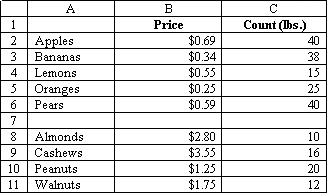
Returns the reference of the cell at the intersection of a particular row and column. If the reference is made up of nonadjacent selections, you can pick the selection to look in.
The INDEX function has two syntax forms: array and reference. The array form always returns a value or an array of values; the reference form always returns a reference.
Syntax 2
Reference form
INDEX(reference,row_num,column_num,area_num)
Reference is a reference to one or more cell ranges.
Row_num is the number of the row in reference from which to return a reference.
Column_num is the number of the column in reference from which to return a reference.
Area_num selects a range in reference from which to return the intersection of row_num and column_num. The first area selected or entered is numbered 1, the second is 2, and so on. If area_num is omitted, INDEX uses area 1.
For example, if reference describes the cells (A1:B4,D1:E4,G1:H4), then area_num 1 is the range A1:B4, area_num 2 is the range D1:E4, and area_num 3 is the range G1:H4.
After reference and area_num have selected a particular range, row_num and column_num select a particular cell: row_num 1 is the first row in the range, column_num 1 is the first column, and so on. The reference returned by INDEX is the intersection of row_num and column_num.
If you set row_num or column_num to 0 (zero), INDEX returns the reference for the entire column or row, respectively.
Remarks
Examples
On the following worksheet, the range A2:C6 is named Fruit, the range A8:C11 is named Nuts, and the range A1:C11 is named Stock.

INDEX(Fruit,2,3) equals the reference C3, containing 38
INDEX((A1:C6,A8:C11),2,2,2) equals the reference B9, containing $3.55
SUM(INDEX(Stock,0,3,1)) equals SUM(C1:C11) equals 216
SUM(B2:INDEX(Fruit,5,2)) equals SUM(B2:B6) equals 2.42